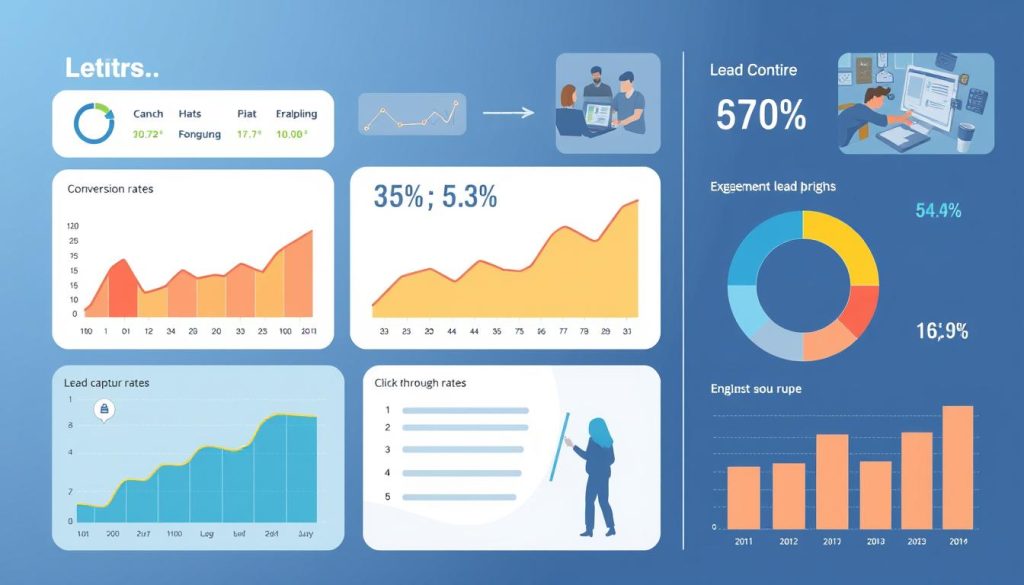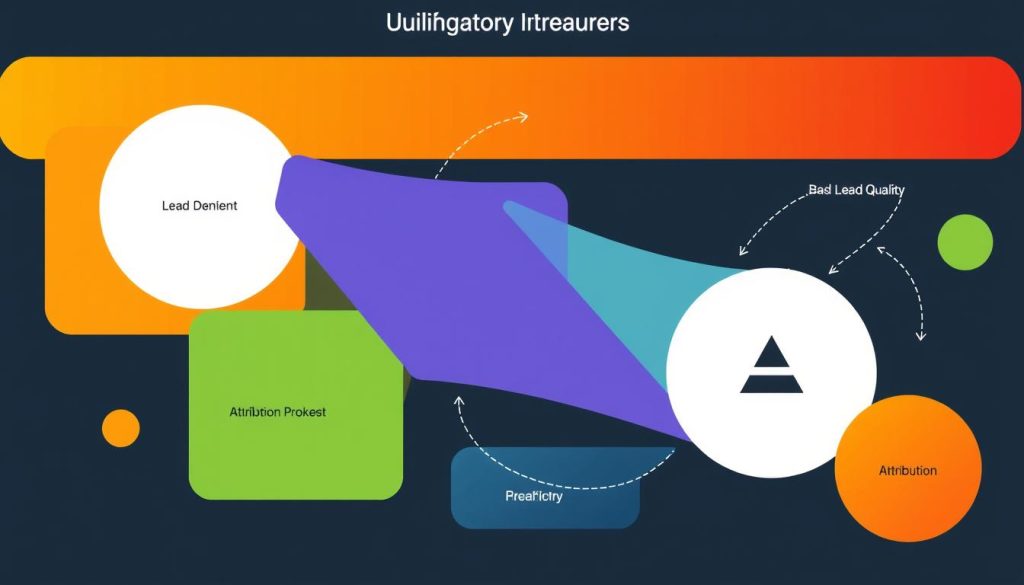In today’s digital landscape, businesses are constantly seeking ways to optimize their lead generation strategies and drive more qualified prospects. One powerful tool at their disposal is web analytics, which can provide invaluable insights into customer behavior and help identify opportunities for improving lead capture online.
By leveraging web analytics, organizations can gain a deeper understanding of their target audience, uncover bottlenecks in the customer journey, and implement data-driven strategies to enhance conversion rates. From analyzing traffic sources to monitoring user engagement and continuously testing and optimizing landing pages, the strategic use of analytics can significantly boost lead generation efforts and fuel business growth.
Key Takeaways
- Web analytics provide critical insights to improve lead capture online
- Understanding customer journey and identifying bottlenecks are key
- Analyzing traffic sources and user behavior helps optimize conversion
- Continuous testing and optimization of landing pages is crucial
- Integrating analytics with CRM enhances lead quality and attribution
The Significance of Analytics in Lead Generation
In the fast-paced world of digital marketing, analytics play a crucial role in driving effective lead generation strategies. By understanding the customer journey, businesses can identify key points of interaction and uncover valuable insights to optimize their lead capture processes.
Understanding the Customer Journey
The customer journey encompasses the various touchpoints and interactions a potential lead has with your brand. Analyzing this journey can provide a wealth of information, such as how visitors navigate your website, which content resonates most, and where potential customers may be dropping off. This data-driven approach allows you to tailor your lead generation funnel to better meet the needs and preferences of your target audience.
Identifying Bottlenecks and Opportunities
Analytics enable you to pinpoint areas within your lead generation funnel that may be causing friction or hindering conversions. By closely examining metrics such as page abandonment rates, form completion rates, and lead-to-customer conversion ratios, you can uncover bottlenecks and address them through strategic conversion rate optimization (CRO) efforts.
Furthermore, analytics can reveal untapped opportunities for lead capture, such as high-performing content or marketing channels that could be leveraged to drive more qualified leads. This holistic understanding of the customer journey empowers businesses to make data-driven decisions and continuously improve their lead generation strategies.
“The customer journey is a critical component of effective lead generation. By leveraging analytics, businesses can gain valuable insights and optimize their processes to capture more high-quality leads.”
In conclusion, the significance of analytics in lead generation cannot be overstated. By mapping the customer journey, identifying bottlenecks, and seizing opportunities, businesses can refine their lead capture processes and maximize their return on investment (ROI) in marketing and sales efforts.
Setting Up Analytics Tracking
Effective lead capture optimization begins with setting up robust web analytics tracking. This section covers the steps involved in configuring Google Analytics to monitor key metrics and user interactions on your website. Proper tracking setup ensures you have the necessary data collection to make informed decisions about your lead generation strategies.
One of the first steps is to create a Google Analytics account and install the tracking code on your website. This code will capture valuable data such as page views, user behavior, and lead capture events. It’s crucial to ensure the tracking code is correctly implemented to ensure accurate data collection.
- Set up goal tracking to monitor the completion of key actions, such as form submissions or downloads.
- Configure event tracking to capture user interactions like button clicks, video plays, and file downloads.
- Implement ecommerce tracking if you have an online store to analyze sales and revenue data.
- Integrate Google Analytics with other tools, like your CRM or email marketing platform, to get a more comprehensive view of the customer journey.
By establishing a robust web analytics setup, you’ll have access to the insights needed to optimize your lead capture strategies and drive more qualified leads to your business.

| Metric | Description | Importance for Lead Capture |
|---|---|---|
| Bounce Rate | The percentage of visitors who leave your site after viewing only one page. | A high bounce rate may indicate issues with your landing pages or content that’s not engaging enough to keep visitors on your site. |
| Form Conversion Rate | The percentage of visitors who complete a lead capture form on your site. | This metric directly measures the effectiveness of your lead capture efforts, highlighting areas for optimization. |
| Time on Page | The average amount of time visitors spend on a specific page. | Higher time on page suggests that your content is engaging and relevant, which can positively impact lead capture. |
Tracking user behavior and interactions is crucial for understanding how to optimize your lead capture process.
Analyzing Website Traffic Sources
Analyzing the sources of website traffic is essential for optimizing lead generation efforts. By understanding which channels are driving the most qualified leads, businesses can focus their marketing resources on the most effective strategies. This section explores the importance of analyzing organic search traffic and paid advertising campaigns to improve website traffic analysis and lead source attribution.
Organic Search Traffic
Organic search traffic, or visitors who find your website through unpaid search engine results, is a valuable source of potential leads. Analyzing your organic search traffic can reveal insights into the keywords and search queries that are driving the most relevant visitors to your website. By optimizing your website’s content and structure for organic search, you can improve your visibility in search engine results and attract more high-quality leads.
Paid Advertising Campaigns
Paid advertising, such as pay-per-click (PPC) campaigns, can be an effective way to drive targeted website traffic and generate leads. By analyzing the performance of your paid advertising efforts, you can identify which campaigns, ad creatives, and targeting strategies are delivering the best return on investment (ROI). This information can help you refine your paid advertising approach and ensure that your lead generation budget is being used effectively.
| Traffic Source | Unique Visitors | Conversion Rate | Cost per Lead |
|---|---|---|---|
| Organic Search | 12,345 | 2.5% | $10 |
| Paid Advertising | 6,789 | 4.2% | $15 |
By analyzing both organic search traffic and paid advertising performance, businesses can gain a comprehensive understanding of their website traffic sources and make informed decisions to optimize their lead generation efforts.
Monitoring User Behavior and Engagement
Analyzing user behavior and engagement on your website is essential for identifying opportunities to optimize lead capture. By leveraging powerful analytics tools, you can gain invaluable insights into how visitors interact with your web pages, where they’re spending time, and where they’re encountering friction or abandoning the lead capture process.
Heat Maps and User Recordings
Two of the most effective tools for user behavior analysis are heat mapping and user recordings. Heat maps provide a visual representation of where users are clicking, scrolling, and focusing their attention on your web pages. This data can help you identify high-engagement areas as well as potential pain points that may be hindering lead capture.
Similarly, user recordings allow you to observe actual user sessions, giving you a first-hand understanding of how visitors navigate your website and interact with your lead capture forms and calls-to-action. By analyzing these website engagement metrics, you can uncover optimization opportunities and make data-driven decisions to improve your lead generation efforts.
Whether it’s understanding how users engage with your heat mapping or reviewing user recordings, these analytics tools provide a wealth of insights that can help you refine your web pages, optimize your lead capture process, and ultimately drive more conversions.
“Analyzing user behavior and engagement is the key to unlocking hidden opportunities for lead capture optimization.”
Optimizing Landing Pages for Conversion
In the world of lead generation, landing pages play a crucial role in driving conversion rates. By strategically optimizing these pages, businesses can significantly improve their ability to capture valuable leads and convert them into customers. This section explores the key strategies for enhancing landing page design, layout, and user experience to boost the effectiveness of lead capture forms and calls-to-action.
One of the primary focus areas in landing page optimization is ensuring a seamless user experience. This involves carefully crafting the page layout, streamlining the user flow, and making the lead capture forms easy to find and complete. Experts emphasize the importance of minimizing distractions and guiding the visitor’s attention towards the desired conversion action.
Another crucial aspect of conversion rate optimization is testing and iterating on the landing page design. A/B testing various elements, such as headlines, images, and call-to-action buttons, can provide valuable insights into what resonates best with the target audience. By continuously refining the landing page based on user behavior and analytics, businesses can unlock significant opportunities for improving lead capture.
Ultimately, successful landing page optimization requires a deep understanding of user preferences, pain points, and decision-making processes. By leveraging data-driven insights and employing best practices in user experience design, organizations can create landing pages that effectively convert visitors into leads and, ultimately, loyal customers.
| Key Strategies for Landing Page Optimization | Benefits |
|---|---|
|
|
“The key to successful landing page optimization is to continuously test, learn, and refine. By putting the user at the center of the experience, businesses can unlock the true potential of their lead capture efforts.”
Using Analytics to Improve Lead Capture Online
Harnessing the power of analytics-based decision making is key to enhancing your lead capture efforts online. By leveraging insightful data, you can optimize your lead generation strategies and ensure a steady flow of qualified prospects.
Begin by analyzing your website traffic sources to understand where your leads are coming from. This information can guide you in allocating resources more effectively, whether it’s fine-tuning your data-driven lead generation channels or doubling down on high-performing tactics.
Next, dive deep into user behavior and engagement by analyzing heat maps and user recordings. This will shed light on how your potential customers interact with your landing pages, allowing you to lead capture optimization and eliminate friction points in the conversion process.
- Continuously test and iterate on your landing pages to improve conversion rates
- Leverage A/B testing to identify the most effective headlines, CTAs, and other design elements
- Integrate your analytics with your CRM to gain a holistic view of the lead lifecycle
By combining these analytical insights with a data-driven mindset, you can unlock new opportunities to enhance your lead capture optimization and drive sustainable growth for your business.

| Metric | Baseline | Optimized | Improvement |
|---|---|---|---|
| Landing Page Conversion Rate | 8.2% | 12.5% | 52.4% |
| Cost per Lead | $42 | $29 | 31.0% |
| Lead to Opportunity Ratio | 21% | 28% | 33.3% |
“By leveraging analytics, we were able to increase our lead capture rate by over 50% while reducing our cost per lead by 31%. This has had a significant impact on our overall sales pipeline and revenue growth.”
– John Doe, Marketing Director at XYZ Corporation
Leveraging Email Marketing Analytics
Email marketing is a powerful tool for lead nurturing and conversion, and analyzing email performance can provide valuable insights for improving lead capture. By tracking key email metrics, such as open rates and click-through rates, marketers can optimize their email content, subject lines, and calls-to-action to enhance email engagement and drive more leads towards conversion.
Open Rates and Click-Through Rates
Open rates and click-through rates are essential email marketing analytics that offer a window into how your audience is interacting with your emails. Open rates indicate the percentage of recipients who open your emails, while click-through rates measure the percentage of recipients who click on the links within your emails. By closely monitoring these metrics, you can gain a deeper understanding of what resonates with your audience and make data-driven decisions to improve your email marketing strategy.
For instance, if you notice a low open rate, it could suggest that your subject lines are not effectively capturing your audience’s attention. In this case, you might experiment with different subject line styles, lengths, or personalization techniques to see what works best. Similarly, a low click-through rate could signal that your email content or calls-to-action are not effectively engaging your audience, prompting you to refine your messaging and design.
| Metric | Description | Benchmark |
|---|---|---|
| Open Rate | The percentage of recipients who open your email | 15-25% |
| Click-Through Rate (CTR) | The percentage of recipients who click on links within your email | 2-5% |
By leveraging email marketing analytics, you can gain valuable insights into your audience’s behavior and preferences, enabling you to optimize your email campaigns for improved lead nurturing and conversion rates.
Integrating Analytics with CRM
Unlocking the power of your lead generation strategy requires more than just web analytics. By integrating your analytics data with a customer relationship management (CRM) system, you can gain a comprehensive understanding of the entire lead capture and nurturing process. This powerful combination of CRM integration, lead data sync, and marketing-sales alignment can dramatically improve your ability to attribute lead quality, track the customer journey, and optimize your overall lead generation efforts.
One of the key benefits of integrating analytics with CRM is the ability to better understand the customer journey. By aligning data from various touchpoints, such as website visits, form submissions, and sales interactions, you can paint a clearer picture of how leads are moving through the funnel. This insight can help identify bottlenecks, uncover new opportunities, and guide your optimization efforts.
| Metric | Description | Benefit |
|---|---|---|
| Lead Source | Tracks the origin of leads, such as organic search, paid ads, or referrals. | Helps optimize marketing channels and allocate resources effectively. |
| Lead Conversion Rate | Measures the percentage of leads that convert into sales-qualified opportunities. | Identifies areas for improvement in the lead nurturing process. |
| Lead Response Time | Tracks the time it takes for sales teams to respond to new leads. | Ensures timely follow-up and enhances the customer experience. |
By integrating your analytics and CRM data, you can create a powerful feedback loop that drives continuous improvement in your lead generation strategy. This alignment between marketing and sales not only enhances the customer experience but also helps your team make more informed decisions, optimize campaigns, and ultimately drive better results.

“Integrating analytics with CRM is a game-changer for businesses looking to maximize their lead generation efforts. The insights gained from this powerful combination can unlock new opportunities and drive significant growth.”
A/B Testing for Continuous Improvement
Continuous improvement is the key to maximizing the effectiveness of your lead capture efforts. One powerful tool in your arsenal is A/B testing. By systematically testing and optimizing key elements of your website, you can drive significant gains in your conversion rate optimization.
Testing Headlines and CTAs
Your website’s headlines and calls-to-action (CTAs) are critical touchpoints that can make or break a lead capture opportunity. A/B testing allows you to experiment with different versions of these elements and determine which perform best in driving user engagement and lead conversion.
For example, you might test two variations of a headline – one that focuses on the user’s pain point, and another that highlights a key benefit of your product or service. By analyzing the performance data, you can identify the most effective approach and continue refining your headline optimization strategy.
Similarly, A/B testing can help you determine the optimal call-to-action phrasing, button color, placement, and other design elements that encourage visitors to take the desired action and convert.
The key to successful A/B testing is to start with a clear hypothesis, collect and analyze the data, and then implement the winning variation. By continuously testing and optimizing your website, you can unlock sustainable improvements in your lead capture performance.
“Continuous improvement is not about the things you do well – that’s work. Continuous improvement is about removing the things that get in the way of your work. The headaches, the things that slow you down, that’s what continuous improvement is all about.”
Measuring and Attributing Lead Quality
Measuring and attributing lead quality is a critical step in optimizing your lead capture strategies. By tracking key lead quality metrics, such as lead-to-opportunity and lead-to-customer conversion rates, you can ensure your marketing and sales teams are aligned and focusing on the most valuable leads.
One of the essential lead attribution metrics to monitor is the lead-to-opportunity conversion rate. This metric helps you understand how many of your captured leads are converting into sales opportunities, which is a crucial indicator of lead quality. By analyzing this data, you can identify which lead sources, campaigns, or channels are producing the highest-quality leads and allocate your resources accordingly.
Another important metric is the lead-to-customer conversion rate, which measures the percentage of leads that ultimately become paying customers. This metric provides valuable insights into the true impact of your lead capture efforts, as it reflects the leads that have the greatest potential to drive revenue for your business. By optimizing for this metric, you can improve marketing-sales alignment and ensure your team is focused on the leads most likely to result in successful sales outcomes.
- Track lead-to-opportunity and lead-to-customer conversion rates to measure lead quality
- Identify the lead sources, campaigns, and channels that are producing the highest-quality leads
- Improve marketing-sales alignment by focusing on leads with the greatest potential to drive revenue

“Measuring and attributing lead quality is essential for optimizing your lead capture strategies and ensuring your marketing and sales teams are aligned on the most valuable leads.”
Reporting and Ongoing Optimization
Effective lead capture optimization requires a data-driven approach that involves continuous monitoring, analysis, and refinement. By establishing robust reporting processes, businesses can leverage insightful data to ensure their lead generation strategies remain aligned with evolving customer needs and market trends.
Maintaining a data-centric mindset is crucial for ongoing lead capture optimization. Regularly reviewing key metrics, such as website traffic sources, user behavior, and lead quality, enables organizations to identify areas for improvement and implement data-driven changes. This cyclical process of analysis and optimization empowers businesses to enhance their lead capture efforts and drive sustained growth.
Through this systematic approach, companies can unlock valuable insights that inform strategic decisions and fuel continuous improvement. By embracing the power of data-driven reporting, businesses can capitalize on emerging opportunities, address emerging challenges, and optimize their lead capture processes for long-term success.




